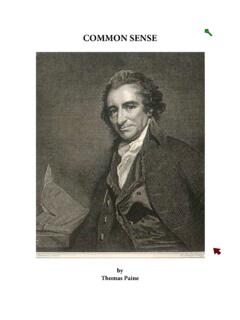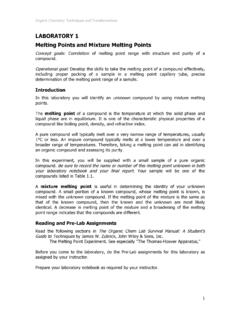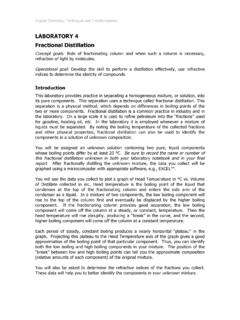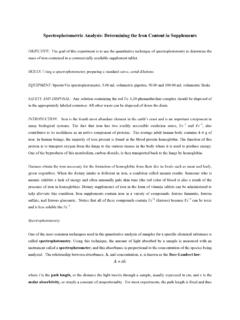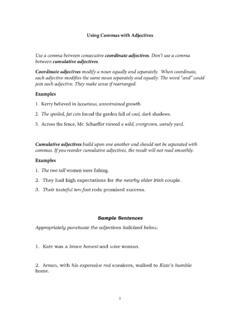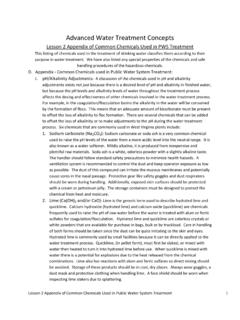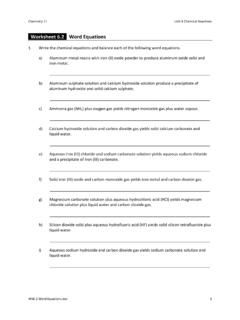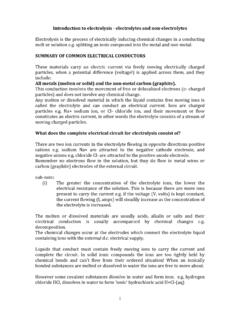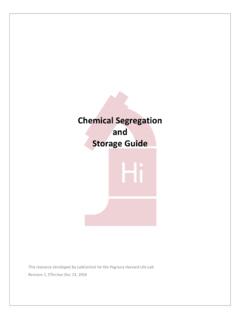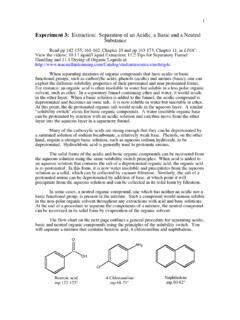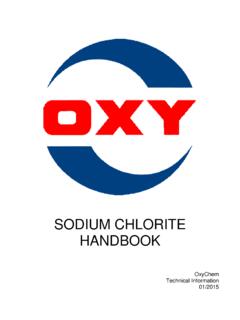Transcription of LABORATORY 5 Extraction - Stockton University
1 Organic Chemistry: Techniques and Transformations 1 LABORATORY 5 Extraction Concept goals: Correlation of structure, polarity, acid and base characteristics and separation efficiency, role of Extraction in separation rather than purification of compounds. Operational goal: Develop the skills to perform an Extraction effectively, including the use of appropriate solvents, ability to prevent the formation of an emulsion layer, removing residual water from the organic layer and evaporating the organic solvent. Introduction It is often necessary to separate an organic compound from a mixture of compounds. These mixtures are often derived from natural sources or are the result of synthetic reactions.
2 Extraction is a technique that selectively dissolves one or more of a mixture of compounds into an appropriate solvent. In this experiment you will use the common technique of liquid-liquid Extraction to separate and purify benzoic acid and naphthalene from a mixture to the two. A typical liquid-liquid Extraction involves partitioning a mixture of compounds between two immiscible solvents. Dissolving the mixture in the first solvent and then adding a second immiscible solvent that will selectively dissolve one of the components of the mixture does this. Since the solvents used are immiscible, the two layers are then vigorously mixed to allow the transfer of a dissolved compound from one layer to another.
3 Once the transfer is complete, the two layers are again allowed to form. Separating the two layers then completes the Extraction of one compound from the mixture. The purpose of this LABORATORY is to separate a binary solid mixture by Extraction washing and re-crystallization, into its pure components. Purity will be tested by thin layer chromatography and/or melting point determination. Reading and Pre-Lab Assignments Read the following sections in The Organic Chem Lab Survival Manual: A Student s Guide to Techniques by James W. Zubrick, John Wiley & Sons, Inc. Drying Agents Extraction and Washing Theory of Extraction Using the handbooks (see Zubrick), look up the data you will need for this experiment.
4 This includes the melting point and solubilities (in water and ether) of benzoic acid and COOHB enzoic AcidNaphthaleneOrganic Chemistry: Techniques and Transformations 2 naphthalene as well as the boiling point, solubility in water, and density of diethyl ether or tert-butyl methyl ether. Before you come to the LABORATORY , do the Pre-Lab assignments for this LABORATORY as assigned by your instructor. Prepare your LABORATORY notebook as required by your instructor. Procedure Weigh out g of a 50:50 mixture of benzoic acid and naphthalene (record the exact mass in your notebook) into a 50 mL Erlenmeyer flask. Add 20 mL of tert-butyl methyl ether and swirl to dissolve. Save a small portion (about mL) of this dissolved mixture for TLC analysis.
5 Transfer the solution to a separatory funnel using a little ether to rinse the flask. Add 10 mL of a 1 M sodium hydroxide solution to the funnel. Stopper the funnel and carefully mix the contents. Vent the funnel and then shake the mixture thoroughly, venting often. Allow the layers to separate completely, remove the stopper from the funnel, and then draw off the lower layer into a labeled 50 mL Erlenmeyer flask. At this point, identify the layers in the flask and the in the funnel as the aqueous layer and ether layer. (See Dutch Uncle Advice , Zubrick.) Reserve a small portion of the ether layer for TLC analysis. Extract the ether layer twice more with 5 mL portions of fresh 1M sodium hydroxide solution.
6 The rationale behind extracting three times with smaller volumes, rather than using the full 20 mL in a single Extraction , is that a larger fraction of the compound being extracted will move into the aqueous phase over multiple extractions. Your instructor may demonstrate this principle as part of the pre-lab discussion. Add these aqueous extracts to the original aqueous extract and set aside. Wash the ether layer with 10 mL of a saturated aqueous sodium chloride solution. Combine this aqueous wash layer with the previous aqueous Extraction layers. Acidify the aqueous extracts by addition of 3M hydrochloric acid while stirring with a glass stirring rod (add the acid dropwise towards the end of the addition).
7 It should take 6-7 mL of hydrochloric acid (if you have 20 mL of 1M base!) Periodically test the pH by transferring a drop of the solution onto a small piece of litmus paper on a watch glass. Benzoic acid is only sparingly soluble in cold acidic water. Once the solution is acidic, place the flask in an ice-water bath for 5 minutes to complete the crystallization. Collect the crystals of benzoic acid by vacuum filtration using a small Hirsch funnel. Let the crystals dry in air. When your sample is dry, measure the mass and calculate your percent recovery. Take a melting point and assess its purity by comparing the measured melting point with the literature value. Reserve a small sample of your benzoic acid product crystals for TLC analysis.
8 Transfer the ether layer into a 50 mL Erlenmeyer flask, taking care not to transfer any residual water. Add 2 g of anhydrous calcium chloride to the flask and set it aside. (Note: If you have excess water mixed with the ether solution you may need to add additional anhydrous calcium chloride.) Organic Chemistry: Techniques and Transformations 3 Decant (pour off) the ether solution into a tared (previously weighed) 50 mL Erlenmeyer flask, taking care to leave all of the drying agent behind. Wash the flask and drying agent with a little ether and add it to the tared flask. Save a small sample of the ether liquid mixture for TLC analysis. You have two options to retrieve the product from your ether (organic) layer.
9 Option 1: Place a boiling stick in the flask and evaporate the ether by placing the flask on a hot plate in your fume hood. Keep your hot plate just warm enough to boil the ether. If your hot plate is too hot you may evaporate or char the naphthalene. When the ether has completely evaporated, a small amount of oil will remain. Remove the flask from the hot plate (too much heat causes naphthalene to sublime) and allow it to cool to room temperature and crystallize. The naphthalene should be nearly colorless. Option 2: A superior procedure for recovering the naphthalene from the ether layer uses a rotary evaporator. This device is often used in research laboratories to quickly remove low boiling solvents from reaction mixtures by heating the mixture under a vacuum in a rapidly rotating round-bottomed flask.
10 As the flask rotates, a thin layer of volatile solvent evaporates and is collected in a condenser. If your instructor chooses to use this device, Decant your ether solution into a tared (previously weighed) 100 mL round-bottomed flask and follow your instructors specific directions for using the rotary evaporator. If necessary, you can recrystallize the naphthalene from methanol and water. Measure the mass and calculate your percent recovery. Take a melting point and assess its purity by comparing the measured melting point with the literature value. Save a small sample of the Naphthalene crystals for TLC analysis. Determining the purity of the separated components: TLC You need 4 mL of developing solvent to run a TLC.
